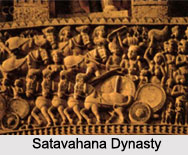 Features of Satavahana dynasty played the most important function in Indian history in the era between the drop of the Mauryas and the growth of Gupta Empire. The Satavahana rulers are popular for their contribution to Buddhist art and architecture. In places like Goli, Jaggayapeta, Ghantasala, Bhattiprolu, Amaravati and Nagarjunakonda the Satavahana sculptures are scattered.
Features of Satavahana dynasty played the most important function in Indian history in the era between the drop of the Mauryas and the growth of Gupta Empire. The Satavahana rulers are popular for their contribution to Buddhist art and architecture. In places like Goli, Jaggayapeta, Ghantasala, Bhattiprolu, Amaravati and Nagarjunakonda the Satavahana sculptures are scattered.
History of Satavahana Sculptures
The Satavahana Empire performed as the successor to the Mauryan Empire in Deccan. In the first century B.C. the Satavahana dynasty rose in eminence in Deccan for the following three centuries. The originator of Satavahana dynasty is believed to be King Simuka. He overthrew the Kanva King Susarman and demolished the Sungas. Sculptures of Amravati symbolize the architectural expansion of the Satavahana periods. They built Buddhist stupas in Amravati and they also created a great number of stupas at Goli, Jaggayapeta, Ghantasala and Amravati Bhattiprolu and Shri Parvatam. Caves 9 and 10 of Ajanta paintings were patronized by Satavahana. Ashokan Stupas were increased the previous bricks and wood works were replaced with stone works.
Characteristics and woks of Satavahana Sculptures
One of the main features of Satavahana sculptures is that these are not iconic. Satavahana denies any representation in human form. It is during the reign of Satavahanas that the Amaravati School of sculpture evolved. Throughout the sculptures, the main theme is of showing various episodes revolving around the Buddha and his life.
The outstanding example of the sculpture of that ages and art of Satavahanas is the depiction of the Enlightened Buddha. The images of Buddha are mainly in the `sthanaka` i.e. standing or `asana` i.e. sitting position and marvellously portray a serene oval face of Lord Buddha with a moderately built body. The images in sitting position shows striking similarity with each others in carving rounded shoulders. In many images, the right hand of Buddha is held up to give a symbolic gesture of `abhaya` means protection- or `pravachana` means preaching.
The Satvahana leaders took interest in sculpture, building caves, viharas or monasteries, chaityas or large halls with a number of columns and stupas. The Buddhist themes dominate the entire picture of artistic creations, although some scholars have evidences to show the influence of the Naga tradition on the art. Another notable work is Nagarjunakonda which main theme was showing the different episodes of Buddha and his life. The popular and famous Chaitya hall built at Karle is another example of magnificence of Satavahana Sculptures. The hall is more than 124 feet long 46 feet abroad and 46 feet high. The Amravati sculptures show some of the traces of the influence of the Gandhara and the Mathura schools to some extent. The theme of nature and related things are most charmingly depicted through the art of carving with emphasizing on vigour, activity and grace. The erotic sculptures are less in numbers but can be marked with their presence. The female figures are carved sensuously and the erotic appeal of the figures and situations is felt easily.



